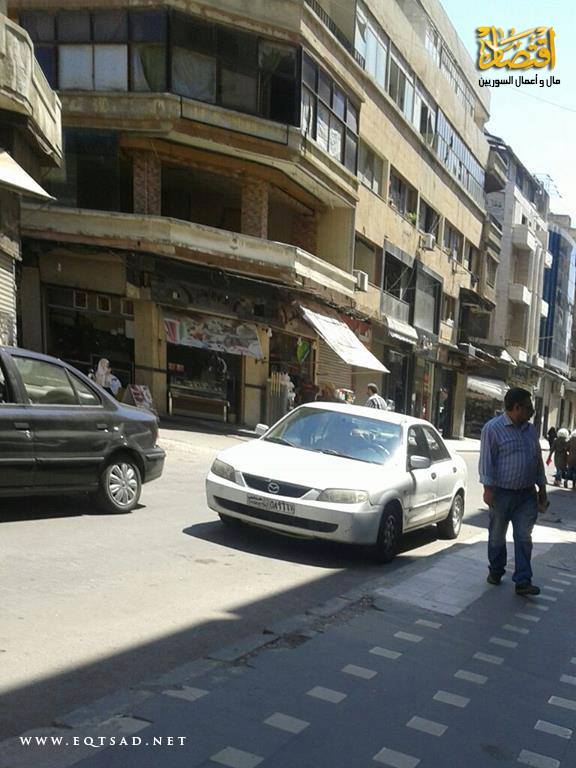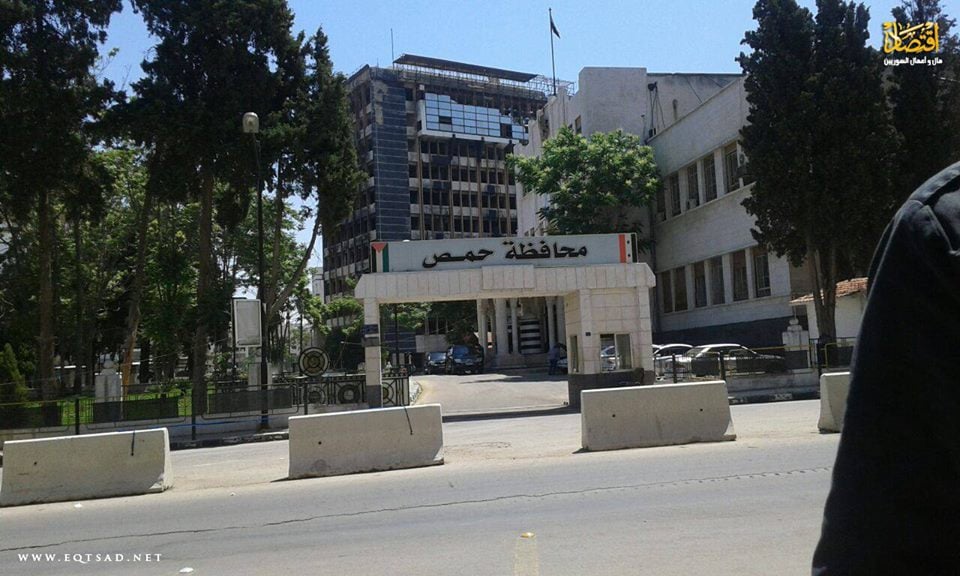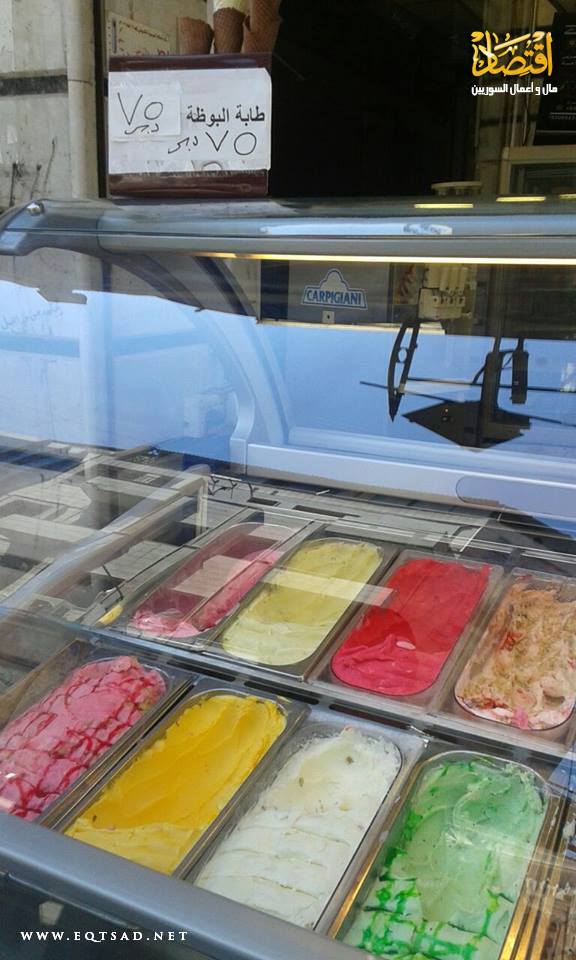(EQTSAD)- Here is Homs city which was and still is the capital of the Syrian revolution in the eyes and minds of the revolutionaries after years of destruction and theft by the hands of its executioners who attempted to hide its milestones to punish it for uprising.
Today, the one who tried to kill Homs attempt to restore it again or to say the to the world, “here is Homs where there is no revolution; a safe zone under oppression, death, forced displacement and arrest.”

After destroying all houses and shops in rebels’ neighborhoods using all kinds of weapons and killing as a collective punishment, the neighborhoods are emptied from its own population like al-Khaldiye, al-Dablan street, Jawret al-Shayah whereas the regime until know enforce a blockade on al-Waer neighborhood and starve its population. Al-Waer though is still steadfast and outside regime control.
In contrast, we look at regime-held areas in Homs which did not witness any destruction except for bomb attacks mostly committed by regime apparatus to keep the loyalty and sectarian tension.
The residents of pro-regime areas in Homs participated in the oppressing, robbing and killing like Akrameh, al-Nuzha, al-Hadara and al-Zahra neighborhoods.

Following exit of rebels from neighborhoods in Old Homs and the cease of bombardment and battles and considering the city became empty of rebels except for besieged al-Waer neighborhood, Homs neighborhoods became overcrowded due to hosting displaced Syrians from all Syrian provinces. The noise slowly returned to the neighborhoods which were outside battles and life returned to streets. However, the only radical difference is the change of its residents.
After finishing off the revolution, life started to return to normal in some neighborhoods in Homs. Most important of which are al-Zahra, al-Nuzha, al-Hadara, al-Abasiyeh, Akrameh, al-Shamas, Karam al-Shami, Tarek al-Sham, al-Dablan, al-Inshaat, and al-Hamra.
The regime and its apparatus worked to return life to normal like providing transport inside the city with a cost of 35 SP per passenger.
One of the first procedures to return life to the city is working to revive famous al-Dablan street since beginning of 2016. The government centers were reactivated in the street like province office, police headquarters, al-Saraya, municipality, teachers’ union, Homs power company, education directorate, and school health center.

Schools also reopened in al-Dablan and its surrounding after becoming overcrowded with displaced Syrians who pay rent between 20-40 thousand SP while shop rents vary between 30-50 thousand SP.
The regime as well opened a center for immigration and passports in the area and a foreign ministry office behind province office close to the new clock. The center certifies official documents. Documents are certified by the foreign office with a fee between 85-150 SP according to the document. The documents which will be used abroad are certified by foreign ministry in Damascus exclusively.
Those who know the city of Homs well can tell the radical changes in the city. The locals of Homs are quite absent from the scene.
(Translation by Rana Abdul)
Today, the one who tried to kill Homs attempt to restore it again or to say the to the world, “here is Homs where there is no revolution; a safe zone under oppression, death, forced displacement and arrest.”

After destroying all houses and shops in rebels’ neighborhoods using all kinds of weapons and killing as a collective punishment, the neighborhoods are emptied from its own population like al-Khaldiye, al-Dablan street, Jawret al-Shayah whereas the regime until know enforce a blockade on al-Waer neighborhood and starve its population. Al-Waer though is still steadfast and outside regime control.
In contrast, we look at regime-held areas in Homs which did not witness any destruction except for bomb attacks mostly committed by regime apparatus to keep the loyalty and sectarian tension.
The residents of pro-regime areas in Homs participated in the oppressing, robbing and killing like Akrameh, al-Nuzha, al-Hadara and al-Zahra neighborhoods.

Following exit of rebels from neighborhoods in Old Homs and the cease of bombardment and battles and considering the city became empty of rebels except for besieged al-Waer neighborhood, Homs neighborhoods became overcrowded due to hosting displaced Syrians from all Syrian provinces. The noise slowly returned to the neighborhoods which were outside battles and life returned to streets. However, the only radical difference is the change of its residents.
After finishing off the revolution, life started to return to normal in some neighborhoods in Homs. Most important of which are al-Zahra, al-Nuzha, al-Hadara, al-Abasiyeh, Akrameh, al-Shamas, Karam al-Shami, Tarek al-Sham, al-Dablan, al-Inshaat, and al-Hamra.
The regime and its apparatus worked to return life to normal like providing transport inside the city with a cost of 35 SP per passenger.
One of the first procedures to return life to the city is working to revive famous al-Dablan street since beginning of 2016. The government centers were reactivated in the street like province office, police headquarters, al-Saraya, municipality, teachers’ union, Homs power company, education directorate, and school health center.

Schools also reopened in al-Dablan and its surrounding after becoming overcrowded with displaced Syrians who pay rent between 20-40 thousand SP while shop rents vary between 30-50 thousand SP.
The regime as well opened a center for immigration and passports in the area and a foreign ministry office behind province office close to the new clock. The center certifies official documents. Documents are certified by the foreign office with a fee between 85-150 SP according to the document. The documents which will be used abroad are certified by foreign ministry in Damascus exclusively.
Those who know the city of Homs well can tell the radical changes in the city. The locals of Homs are quite absent from the scene.
(Translation by Rana Abdul)
















Comments About This Article
Please fill the fields below.